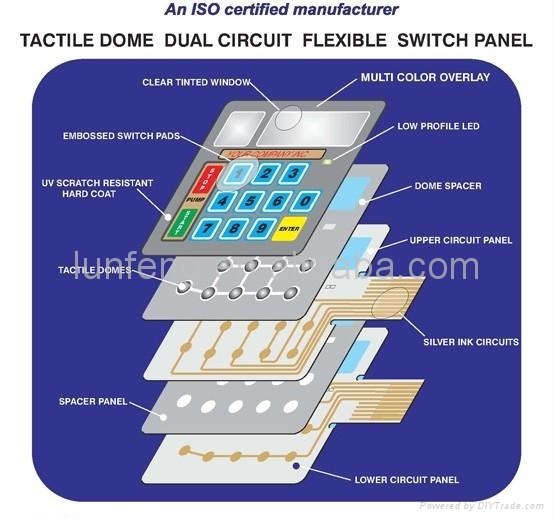Membrane Switches: A Cost-Effective Solution for Product Interfaces
Discover How Membrane Switches Function and Their Role in Modern Electronics
Membrane Switches stand for a sophisticated assimilation of technology and style within the world of contemporary electronics, serving as essential interfaces in many gadgets. Understanding the details of Membrane switch capability and their broader ramifications in boosting customer experience invites additional expedition right into their design, advantages, and the ingenious growths shaping their future in innovation.
What Are Membrane Buttons?

Membrane buttons are identified by their resilience and resistance to environmental aspects, such as dirt, wetness, and severe temperature levels. They can be tailored with numerous graphics, shades, and responsive feedback options, enhancing user experience while maintaining aesthetic appeal - membrane switches. Additionally, the consolidation of printed circuits enables seamless integration into devices, improving overall functionality.
The convenience of Membrane buttons is obvious in their capability to support both intricate and easy control features. They can include functions such as LED signs and touch-sensitive innovation, accommodating specific customer demands. As innovation remains to advance, Membrane Switches continue to be necessary for allowing intuitive and efficient interface, consequently playing a critical role in the innovation of contemporary electronic gadgets.
Components of Membrane Switches
Membrane switches are made up of a number of key elements that collaborate to produce a trusted and functional user interface. The primary components include the visuals overlay, adhesive layer, spacer layer, and conductive traces.
The visuals overlay works as the interface, generally published on a flexible substratum such as polyester or polycarbonate. This layer not only supplies visual appeal yet also includes responsive feedback, visual signs, and protective functions. Under the graphic overlay exists the glue layer, which secures the switch to the tool and ensures toughness against environmental anxieties.
The spacer layer is vital for keeping the essential space between the graphic overlay and the circuit layer. This void enables the activation of the button when stress is used. The conductive traces, typically made from silver or carbon, create the electrical paths that complete the circuit when the switch is engaged.
Furthermore, a support layer might be consisted of for structural support and insulation. These elements work together flawlessly, ensuring that Membrane switches are both easy to use and durable, making them essential in different contemporary digital applications.
How Membrane Switches Job
Exactly how do Membrane Switches feature successfully within digital gadgets? Membrane Switches operate on the principles of pressure-sensitive technology, using a split building that includes visuals overlays, sticky layers, and conductive elements.
The layout of Membrane buttons is important for their visit our website effective procedure (membrane switches). The layers are carefully crafted to supply tactile responses, sturdiness, and resistance to environmental elements such as moisture and dirt. The inclusion of domes-- tiny, raised locations within the switch-- boosts tactile action, offering customers with a visible click experience upon activation
Furthermore, Membrane buttons can be personalized in regards to size, shape, and graphics, making them ideal for various applications. They are usually utilized in control panels, clinical devices, and consumer electronic devices due to their smooth layout and reliability. Generally, the reliable functioning of Membrane buttons is pivotal in improving customer interaction and making sure smooth operation in modern-day digital devices.

Applications in Modern Gadgets
Using their unique style and performance, Membrane buttons have become integral components in a vast array of modern-day digital gadgets. These flexible interfaces are utilized in consumer electronic devices, industrial tools, clinical devices, and automotive controls, offering seamless user interaction.
In consumer electronic devices, Membrane buttons are commonly located in appliances like microwaves, cleaning equipments, and other house tools, where they make it possible for instinctive control with a streamlined account. Their low-profile design helps with integration right into portable gadgets, improving aesthetic appeal without endangering capability.
In commercial applications, Membrane Switches offer as control board for equipment, providing sturdiness and resistance to extreme atmospheres. Their ability to withstand dampness and pollutants makes them optimal for use in manufacturing and handling markets.
Medical tools likewise take advantage of Membrane buttons, which are made to be simple to clean and preserve, making certain health in medical setups. They are usually utilized in diagnostic tools, client surveillance systems, and portable clinical gadgets, where reliability is vital.
Advantages of Membrane Switches
Among the key advantages of Membrane buttons is their versatility, which enables them to be tailored for a range of applications throughout several sectors. These switches can be developed in numerous sizes and shapes, accommodating one-of-a-kind product demands while providing smooth assimilation into tools. Their thin profile allows a small and streamlined design, usually enhancing the visual allure of electronic products.
An additional significant advantage is their longevity - membrane switches. Membrane switches are normally immune to dust, wetness, and chemicals, making them excellent for severe atmospheres. This strength expands their lifespan compared to standard mechanical buttons, reducing the need for regular replacements
Furthermore, Membrane Switches deal cost-effectiveness. The production procedure involves printing technologies that decrease manufacturing costs, especially for huge runs. This affordability, combined with low maintenance demands, makes them an eye-catching alternative for manufacturers.

Conclusion
In final thought, Membrane Switches represent a significant innovation in individual interface innovation within modern electronic devices. As the need for user-friendly and resilient user interfaces continues to expand, the role of official site Membrane switches in forming user experience will certainly increase.
Membrane Switches represent a sophisticated assimilation of innovation and check this site out design within the world of contemporary electronic devices, serving as essential interfaces in numerous gadgets.In the realm of contemporary electronic devices, Membrane Switches serve as important components that promote user communication with devices. As modern technology continues to progress, Membrane Switches stay essential for allowing intuitive and effective individual interfaces, therefore playing a critical function in the advancement of contemporary digital tools.
How do Membrane Switches feature effectively within electronic tools? On the whole, the efficient performance of Membrane buttons is pivotal in improving individual communication and ensuring seamless operation in contemporary digital tools.